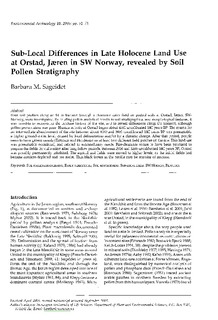Sub-local differences in Late Holocene land use at Orstad, Jæren in SW-Norway, revealed by soil pollen stratigraphy
Journal article, Peer reviewed
Permanent lenke
http://hdl.handle.net/11250/181541Utgivelsesdato
2005Metadata
Vis full innførselSamlinger
- Articles (AmS) [142]
Originalversjon
Sageidet, B.M. (2005) Sub-local differences in Late Holocene land use at Orstad, Jæren in SW-Norway, revealed by soil pollen stratigraphy. Environmental Archaeology, 10(1), 51-71Sammendrag
Four soil profiles along an 84 m transect through a clearance cairn field on podsol soils at Orstad, Jæren, SW Norway,
were investigated. By relating pollen-analytical results to soil stratigraphical and morphological features, it
was possible to reconstruct the landuse history of the site, and to reveal differences along the transect, although
pollen preservation was poor. Human activity at Orstad began about 4500 uncalibrated 14C years BP. The reason for
an intermediate abandonment of the site between about 4000 and 3600 uncalibrated 14C years BP was presumably
a higher ground-water level, caused by local deforestation and/or by a climatic change. After that period, people
seem to have grown cereals (Triticum and Hordeum) on at least two different field patches on the site. This land use
was presumably occasional, and related to extraordinary needs. Fire-clearance seems to have been practised to
prepare the fields for cultivation after long fallow periods. Between 2900 and 3200 uncalibrated 14C years BP, Orstad
was possibly permanently inhabited. The agricultural fields were moved to higher levels, as the initial fields had
become nutrient-depleted and too moist. Thin black layers in the profile may be remains of manure.
Beskrivelse
Made available with permission from Maney Publishing / Environmental Archaeology. www.maneypublishing.com/journals/env and www.ingentaconnect.com/content/maney/env.
